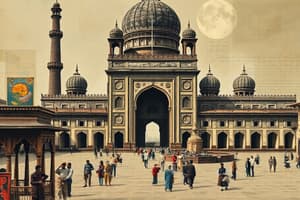Podcast
Questions and Answers
दिल्ली सल्तनत के दौरान किस प्रकार की सांस्कृतिक परंपराएं विकसित हुईं?
दिल्ली सल्तनत के दौरान किस प्रकार की सांस्कृतिक परंपराएं विकसित हुईं?
- केवल संगीत
- केवल साहित्य
- साहित्य, कला और संगीत (correct)
- केवल कला
दिल्ली सल्तनत के प्रशासन में किन धार्मिक समुदायों के लोग शामिल थे?
दिल्ली सल्तनत के प्रशासन में किन धार्मिक समुदायों के लोग शामिल थे?
- केवल हिंदू
- मुस्लिम, हिंदू और सिख
- मुस्लिम और हिंदू दोनों (correct)
- केवल मुस्लिम
लोदी राजवंश का संस्थापक कौन था?
लोदी राजवंश का संस्थापक कौन था?
- मुहम्मद बिन तुगलक
- कुतुबुद्दीन ऐबक
- इब्राहिम लोदी (correct)
- महमूद गजनवी
दिल्ली सल्तनत के किन प्रमुख वास्तुकला नमूनों में इंडो-मुस्लिम शैली का प्रभाव देखा जा सकता है?
दिल्ली सल्तनत के किन प्रमुख वास्तुकला नमूनों में इंडो-मुस्लिम शैली का प्रभाव देखा जा सकता है?
दिल्ली सल्तनत के किस शासक ने तुगलकाबाद किला का निर्माण कराया था?
दिल्ली सल्तनत के किस शासक ने तुगलकाबाद किला का निर्माण कराया था?
दिल्ली सल्तनत के संस्थापक कौन थे?
दिल्ली सल्तनत के संस्थापक कौन थे?
खिलजी वंश के शासन काल में क्या महत्वपूर्ण घटना घटी?
खिलजी वंश के शासन काल में क्या महत्वपूर्ण घटना घटी?
तुगलक वंश के शासन काल में किन शहरों को राजधानी बनाया गया था?
तुगलक वंश के शासन काल में किन शहरों को राजधानी बनाया गया था?
लोदी वंश की राजधानी कहाँ स्थित थी?
लोदी वंश की राजधानी कहाँ स्थित थी?
निम्नलिखित में से किस शासक ने अनेक विफल प्रयास किए थे सम्राज्य का विस्तार करने और राजधानी दिल्ली से स्थानांतरित करने के लिए?
निम्नलिखित में से किस शासक ने अनेक विफल प्रयास किए थे सम्राज्य का विस्तार करने और राजधानी दिल्ली से स्थानांतरित करने के लिए?
Flashcards are hidden until you start studying
Study Notes
Delhi Sultanate
The Delhi Sultanate refers to the Islamic rule in Northern India from the late 13th century until 1526 CE. This era saw various sultanates formed across the Indian subcontinent, with Delhi serving as the capital of several of these Muslim states. Here's a brief overview of the Delhi Sultanate:
History
The Delhi Sultanate was established by Qutbuddin Aibak, who conquered Delhi from the last Hindu king in 1206 CE. Over time, power shifted among different dynasties, each bringing their own cultural influences to the region. Some of the notable sultanates included the following:
Khilji Dynasty
The Khilji dynasty ruled from 1290-1320 CE. This period saw considerable expansion of the Delhi Sultanate, with the capture of Bengal and southern India.
Tughlaq Dynasty
The Tughlaq dynasty ruled from 1320-1413 CE. This period saw the relocation of the capital from Delhi to Tughlaqabad and then to Jaunpur, as well as the construction of the Tughlaqabad Fort.
Lodi Dynasty
The Lodi Dynasty ruled from 1451-1526 CE. This period saw the establishment of the last Lodi Sultanate capital in Agra.
Rulers
Some of the notable rulers of the Delhi Sultanate include:
- Qutbuddin Aibak (1206-1210 CE): The founder of the Delhi Sultanate.
- Iltutmish (1211-1236 CE): The first Sultan of Delhi who was entirely Muslim.
- Muhammad bin Tughlaq (1325-1351 CE): Known for his unsuccessful attempts to expand the empire and move the capital from Delhi.
- Ibrahim Lody (1451-1489 CE): The founder of the Lodi Dynasty.
Administration
The Delhi Sultanate was primarily governed by Muslims, with some Hindus serving in administrative positions. The administration consisted of various departments, including finance, defense, foreign affairs, and justice.
Culture
The Delhi Sultanate was known for its rich cultural traditions. Some aspects of this culture include:
- Literature: The Delhi Sultanate saw the emergence of Persian literature in India. Notable works from this period include the Tuti-nama, which is considered one of the earliest examples of Indian romance literature.
- Art: The Sultanate period witnessed a flourishing of architecture, painting, and sculpture. Examples of this can be seen in monuments such as the Qutub Minar in Delhi, the Khirki Mosque, and the Tughlaqabad Fort.
- Music: The Delhi School of Music emerged during the Sultanate era, characterized by compositions based on Persian poetry.
Architecture
Some notable architectural achievements of the Delhi Sultanate include:
- Qutub Minar: A minaret built by Qutbuddin Aibak in 1206 CE. It stands as a symbol of the early Delhi Sultanate's power.
- Khirki Mosque: Built in 1320 CE, it is one of the oldest surviving examples of Indo-Muslim architectural style.
- Tughlaqabad Fort: A massive fortress constructed by Muhammad bin Tughlaq around 1323 CE. Despite its impressive size, the fort was abandoned soon after its completion.
In conclusion, the Delhi Sultanate played a significant role in shaping the political, social, and cultural landscape of Northern India between the late 13th century and 1526 CE. Its legacy continues to influence contemporary Indian society through its contributions to architecture, literature, music, and more.
Studying That Suits You
Use AI to generate personalized quizzes and flashcards to suit your learning preferences.




